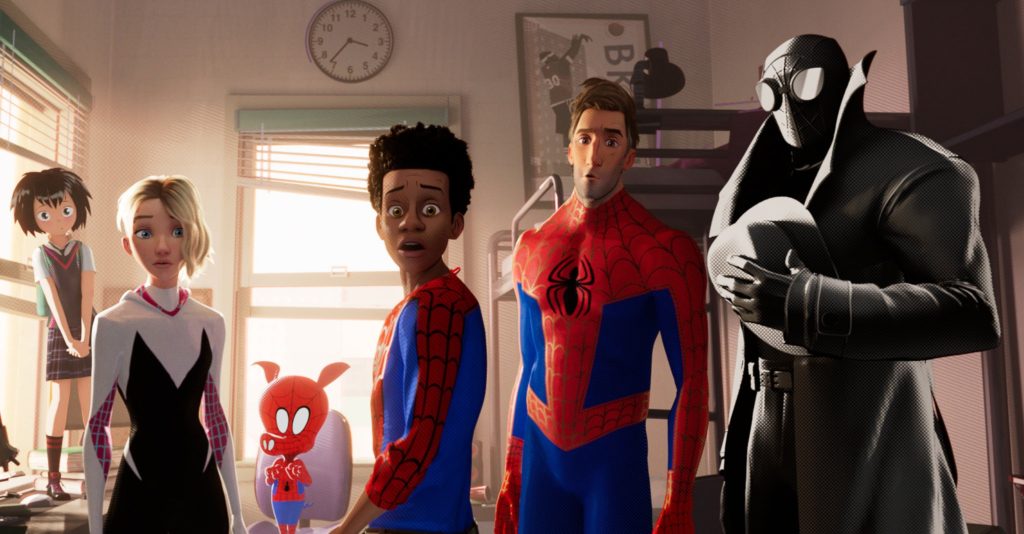JANUARY 2, 2019

Who would have ever thought that the best of the seven Spider-Man films released so far would be the animated one?
Certainly not me, as I went into this Marvel movie with my usual amount of dread. Faithful readers of this column know that I’m not exactly a fan of the comic book genre — the hopeful set-up and good dialogue of Act 1, the plot complications of Act 2, and the inevitably disappointing CGI computer fest that usually clogs up Act 3 — often cause me to walk out asking why I wasted my time.
All of those expectations were turned on their head with “Spider-Man: Into the Spider-Verse,” a Sony Pictures Animation production that takes one of its most valued brands and shakes it up — a brave conceit that turns out to be the best thing ever to happen to Spider-Man.
The film is based on the comic-book character Miles Morales, created by Brian Michael Bendis and Sara Pichelli in 2011. Miles is a 15 year-old Afro Latino (voiced by Shameik Moore) who is bitten by the same radioactive spider that turned Peter Parker (Chris Pine) into Spider-Man.
Miles is having problems enough at home with his dad, policeman Jefferson Davis (Brian Tyree Henry) and his nurse mom Rio Morales (Luna Lauren Velez) who want Miles to aspire upward and place him in a preppy school where he feels he doesn’t fit in. The only people in whom Miles can confide are his beloved uncle Aaron (Mahershala Ali) and his classmate Wanda (Hailee Steinfeld), who thinks that Miles is a goof but likes him anyway.
Miles begins to realize that he has the same Spidey powers as Spider-Man, so he tries to follow the Webbed One and watches as arch-villain Kingpin (Liev Schreiber), who’s built like a brick wall, kills Peter Parker. With his dying breath, Peter hands the Spider-Man mantle over to Miles, who feels that he is as yet unworthy to take it.
It is only then that Miles realizes that there are more Spider-Men in alternate universes when they meet up to help him. There’s an older beer-gutted Peter Parker (Jake Johnson); a Spider-Woman named Gwen Stacy, who turns out to be Wanda from Miles’ school; Spider-Man Noir (Nicolas Cage), a black-and-white Spider-Man from the 1930s; Peni Parker (Kimiko Glenn), a Japanese anime schoolgirl with a radioactive spider sidekick; and Peter Porker (John Mulaney), a Warner Bros.-like animated pig Spider-Man.
Together they bond to take down Kingpin and his cohort, Doc Ock. The Doc Ock character is an important link to what had been the best film in the series, 2004’s “Spider-Man 2,” in which the character has a heartbreaking backstory for going to the dark side. Here Doc Ock has a gender switch and is voiced by Kathryn Hahn. Her Doc is just as tough but without the heartbreak.
What’s cool about “Into the Spider-Verse” is not just its unexpected quality of storytelling but its look. There’s the usual CGI, but its computer rigidity is softened by the hand-drawn 2D images that help transform it to the point that the visuals of “Into the Spider-Verse” has the feel of a genuine comic book.
It’s a very different look for an animated feature that takes just a little getting used to, but instead of taking you out of the film, I found it brought me closer, perhaps mirroring how closely I was drawn to the artwork of comic books as a kid.
“Into the Spider-Verse” is directed by Bob Persichetti, Peter Ramsey and Rodney Rothman, from a script by Rothman and Phil Lord. The film manages to have a distinct comic sensibility that’s wildly different from the other Spider-Man films, and the key to that is likely Lord, who co-produced this film with his partner Christopher Miller. Together they created “The LEGO Movies” and the “21/22 Jump Street” reboot, a group of films that are uproariously funny without being overly nasty. And that approach works surprisingly well here.
There’s also a lovely moment when the late Marvel Comics leader Stan Lee has a speaking part as a comic book store owner that continues Lee’s on-screen appearances in Marvel movies even now after he’s gone. (Lee also has an animated cameo in Disney’s wonderful “Ralph Breaks the Internet.”)
The kind of clunky CGI figures that usually strain to be believable in the third act of most Spider-Man movies are accomplished here with ease thanks to the film’s smooth animation style, so that you leave the theater not being let down by the action finale, which happens so often in other Spidey films.
Yes, “Spider-Man” is lengthy for an animated feature — both this film and “Ralph Breaks the Internet” are close to two hours each — and there are a few moments here and there where the film spins its wheels.
But these are merely quibbles in a film as imaginative as any we’ve seen in recent memory. “Spider-Man: Into the Spider-Verse” is not only the best Spider-Man film so far but also the best animated film of the year.
GRADE: A-











